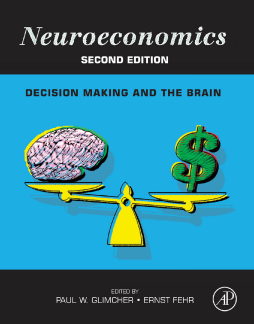
Additional Information
Book Details
Abstract
In the years since it first published, Neuroeconomics: Decision Making and the Brain has become the standard reference and textbook in the burgeoning field of neuroeconomics. The second edition, a nearly complete revision of this landmark book, will set a new standard. This new edition features five sections designed to serve as both classroom-friendly introductions to each of the major subareas in neuroeconomics, and as advanced synopses of all that has been accomplished in the last two decades in this rapidly expanding academic discipline. The first of these sections provides useful introductions to the disciplines of microeconomics, the psychology of judgment and decision, computational neuroscience, and anthropology for scholars and students seeking interdisciplinary breadth. The second section provides an overview of how human and animal preferences are represented in the mammalian nervous systems. Chapters on risk, time preferences, social preferences, emotion, pharmacology, and common neural currencies—each written by leading experts—lay out the foundations of neuroeconomic thought. The third section contains both overview and in-depth chapters on the fundamentals of reinforcement learning, value learning, and value representation. The fourth section, “The Neural Mechanisms for Choice, integrates what is known about the decision-making architecture into state-of-the-art models of how we make choices. The final section embeds these mechanisms in a larger social context, showing how these mechanisms function during social decision-making in both humans and animals. The book provides a historically rich exposition in each of its chapters and emphasizes both the accomplishments and the controversies in the field. A clear explanatory style and a single expository voice characterize all chapters, making core issues in economics, psychology, and neuroscience accessible to scholars from all disciplines. The volume is essential reading for anyone interested in neuroeconomics in particular or decision making in general.
- Editors and contributing authors are among the acknowledged experts and founders in the field, making this the authoritative reference for neuroeconomics
- Suitable as an advanced undergraduate or graduate textbook as well as a thorough reference for active researchers
- Introductory chapters on economics, psychology, neuroscience, and anthropology provide students and scholars from any discipline with the keys to understanding this interdisciplinary field
- Detailed chapters on subjects that include reinforcement learning, risk, inter-temporal choice, drift-diffusion models, game theory, and prospect theory make this an invaluable reference
- Published in association with the Society for Neuroeconomics—www.neuroeconomics.org
- Full-color presentation throughout with numerous carefully selected illustrations to highlight key concepts
"Neuroeconomics is a large, beautifully produced and ambitious book that aims to be to for this emerging field what Gazzaniga’s The Cognitive Neurosciences is for the emerged one. It offers essays on the history of the discipline; reflections on whether (and what, and why) it offers anything of unique value to science; and reports of cutting-edge research in a number of areas including: the neural mechanisms of choice, valuation and social decision-making; the evolutionary origins of economic behavior; and the various ways of using neuroscience data to adjudicate between competing theories in behavioral economics."–Journal of Economic Psychology (Feb 2010)
'Neuroeconomics is a timely collection of papers by leading researchers from both sides of the border between economics and neuroscience. The papers reflect a high level of focused communication between scholars in fields that until recently studied decision-making at different levels using different methods, with little fruitful interaction. The book should be of interest to anyone who would like to know how a deeper understanding of process can enrich and refine economic theories of decision-making; to anyone who would like to know how economic theory can inform research in neuroscience; or simply to anyone who has ever wondered about the mechanics of how decisions are made in the brain, and what it means about human nature.' – Vince Crawford, Distinguished Professor of Economics, University of California, San Diego, USA
'Neuroeconomics: Decision Making and the Brain is a landmark publication in the rapidly expanding field of neuroeconomics. The list of contributors is exceptional. The content is completely up to date and forward looking. For the foreseeable future, this will be the standard reference for newcomers and experienced researchers alike.' – David Laibson, Professor of Economics, Harvard University, USA
'Economists pride themselves of rigorous parsimony. By taking the neural correlates of behavior into account, potentially explanatory variables explode. This book shows when digging deeper nonetheless pays for economics, and how to do it well.' - Christoph Engel, Director, Max Planck Institute for Research on Collective Goods, Bonn, Germany
'This collection of chapters on neuroeconomics provides an integrated introduction to how brains compute value, make choices, interact socially and collectively create economics. Neuroeconomics is also a fascinating story of how a new paradigm emerged from the collision of two parent disciplines and is continuing to evolve in often surprising directions.' - Terrence Sejnowski, Professor and Director, Computational Neurobiology Laboratory, Howard Hughes Medical Institute, Salk Institute for Biological Studies, University of California, San Diego, USA
'For those onlookers who can't quite accept that neuroscience may provide insight into how we decide what course of action to follow, the contributors to this comprehensive volume offer some very compelling, and very serious experimental and theoretical insights. Highly recommended, and enormously provocative.' - Floyd Bloom, Professor Emeritus, Molecular and Integrative Neuroscience Department, The Scripps Research Institute, La Jolla, USA
'Paul Glimcher is one of the founders of and most distinguished contributors to the emerging science of neuroeconomics. He has edited a volume that offers a clear view into the brains of some of the field's most active investigators.' – Alvin E. Roth, George Gund Professor of Economics and Business Administration, Harvard University, USA
